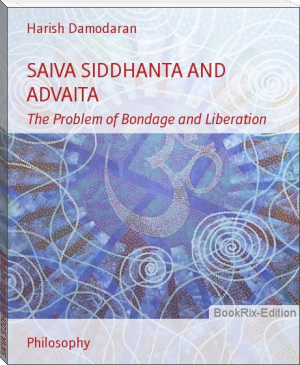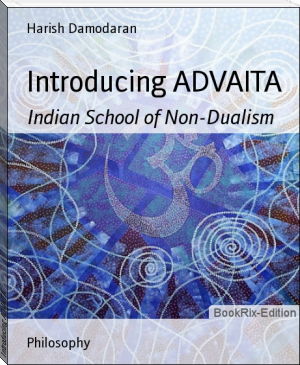SAIVA SIDDHANTA AND ADVAITA, Harish Damodaran [i can read with my eyes shut .TXT] 📗

- Author: Harish Damodaran
Book online «SAIVA SIDDHANTA AND ADVAITA, Harish Damodaran [i can read with my eyes shut .TXT] 📗». Author Harish Damodaran
Anava persists till the body lasts and it vanishes with the body without attaching itself to any other body. In the Jivanmuktha stae it abides without exercising its function29. Though, Anava is anadi (beginingless), it is removed by the grace of the Lord as the verdigris is removed form copper by the alchemist’s stone30.
Thus, it is only the grace of the Pati, that can drive away the Anava like sunlight drives away the darkness.
In short, the soul is desperately bound by three bonds of evils namely Maya, Karma and Anava and its only release rests with the mercy of the ultimate Spirit, Siva.
3.2. Nature of Bondage in Advaita
In Advaita we have the concept of ultimate reality, Brahman, developed by Badarayana and Adi Sankara. They took up the idea from the upanishads where it is denoted by the names, Brahaman, Atman, Purusa, Isvara and soforth.
When we consider the world of finite objects from the logical or the cosmological or even the moral point of view, we find that all things and all arguments lead to a supposition of something that is necessarily larger than the finite. Every explanation, every affirmation and denial pertaining to a finite thing involve a reference to something real and more than finite.
In the world, there are many samanyas or universals and all these samanyas in their graduated series are included and comprehended in one great samanya ie; the Brahman, in the nature of a mass of inteligence.
When we say that Brahman is reality, we mean that it is not spatial or temporal. It is not phenomenal or sensible. Brahman is not a thing because it has no attributes. Brahman is not a thing because it has no relations, either spatial or temporal. Brahman has nothing similar to it because it is not a species under a genus. It has no genus. It is the highest universal.
The Brahaman is one without a second and is non-dual (Advaita). All descriptions of whole and parts, absolute and relative, finite and infinite are transcendent in Brahaman. These descriptions pre- suppose oppositions and opposition characterizes experience.
When we call Brahman as the infinite, we should not equate it as the mere opposite of the finite. To understand the nature of Brahman, we should let go the finite and formal. When the upanisads speak of the Absolute as nirguna (without qualities), what is meant is that it is beyond experience, and beyond the emperical. No gunas, therefore, can belong to the Brahman.
The Brahman is of the nature of ultimate consciousness and yet knows nothing. It is because Brahman is not the consciousness that belongs to a subject that characterizes emperical knowledge. Jnana or knowledge is not its property, but its very essence. Brahman is Jnana. It does not lead to any truth, but it is itself the highest truth.
Brahman is sat because it is not asat. Brahman is cit because it is not acit. Brahman is ananda because it is not of the nature of pain. It is highest truth, perfect being and fullest freedom. The characteristics sat-cit-ananda are not qualities but only negations of non-being. Any quality is a determination and any determination is a negation.
The system of Advaita admits three levels of realties: prathibhasika satya, vyavahariha satya and paramarthika satya. Prathibhasika satya is the reality one experience in his state of dreaming It remains true till he wakes up. Vyavaharika satya reffers to the empirical reality. It is experienced by many, and hence accepted as true. It lasts till the dawn of Brhmanjana. Paramarthika sathya is the absolute reality or state of Brahman. It is the highest end of all.
Since the mankind views things from the empirical point of view, it demands things to be described in its own way. Thus in the vyavaharika level of reality Brahman is viewed as saguna agaist its nirguna aspect in the paramarthika level. Thus empirically Brahman is described as saguna and as the personal god, the creator, the preserver and the refuge of all worlds. Here it is called Isvara. Isvara, in fact is only our conception of Brahman since we are with in the limits of the vyavaharika world. In short, Brahman of nirguna nature as viewed in the paramarthika level is the supreme reality.
In Advaita the individual soul is designated as Jiva. According to the Advaitin the Jiva is not a devotee nor a dependent nor a friend nor an equal to the Brahman. It is Brahman it self. Thus Advaita reaches the climax of theistic speculation where, in a sense the soul and the supreme spirit or the self and God is one and the same.
In Advaita, Jiva is nothing else but Brhman itself .Adi Sankaracharya says the difference observed in the empirical level is an illusion and the world itself is a mithya (appearance).
What makes the Jiva think itself to be different from the Brahman is the Bondage in which it finds itself. Thus it takes itself as a body as existing in a jagat (world) as mortal, as always finite and limited. This happens because, being attached with body it loses the sight of the paramarthika satya and is confined to the empirical world of name and form (namarupa). Thus, it is only a change in the point of view that causes all the problems for the Jiva. Jiva loses the paramarthiika point of view and in its place take up the less real vyavaharika point of view. It has to remain in this state of imprisonment, where it is limited by avidya or ignorance. It has only finite knowledge and limited powers. It is conditional, pragmatic and psychological. The Jiva is personal due to the presence of the mind (manas), intellect (buddhi) and ego (ahankara).
Jiva is the doer (karmin) and enjoyer (bhoktr). It has the characteristics of merit and demerit, pleasure and pain, attachment and aversion, desire and volition. The Jiva remains in the waking, sleeping and dreaming stages. It is subjected to action, bondage, liberation and transformation. To Jiva, all these state of affairs continue, till the final release, the Moksa, where it is identified with the Brahman.
Karma is one of the bonds that binds the Jiva, and it owns a very important position in the philosophy of Advaita.
The term Karma has two meanings. One is the deed or the action and the other is the fruit of an action. Being attached with the material body the Jiva cannot help doing karmas31. It is always doing Karmas. Karmas have their fruits. The doer has to enjoy them irrespective of being good or bad. And this enjoyment leads in to doing further Karmas. They also have their after effects. And this chain continues ad infinitum. In this way the Jiva falls deeper and deeper into the tight grip of Karma. “Mysterious is the way of Karma”, says Bhagavat Geeta32. Where ever the Karma is leading the Jiva or whatever problems it is causing to the Jiva are always unknown and beyond predictions. It leads Jiva from one birth to another and from one Karma to another. Thus it goes on accumulating in the Jiva’s account. The classification of Karmas into Prarabdha, Sanchita and agamika is applicable to Advaita also. For not even a single moment, the Jiva is free from karma.
The Advaita suggests Jnana or knowledge as the means to release from the Karma.
No other single term, in the entire history of philosophical world, has triggered off such a vast population of arguments, disputes and controversies as the term Maya has provoked. It is the very basis of the Advaita theory of causation called viverthavada.
The term Maya is derived from the sanskrit root ma which has been used in different senses viz; to measure, to build, to know etc. Generally it means the first one to measure. Thus the Maya means illusive projection of the world by which the immeasurable Brahman appears as if measured.
The problem of one and the many is a vital question to be answered by a monist. He has to explain, how the one becames many. Hence the doctrine of Maya is cardinal to the school of Advaita Vedanta. Maya is the seed of the world of difference. It is the indescribable world of experience in entirety. Maya is the Principle which makes the one appear as the many.
Maya is not an entity, not a substance and it does not affect the Brahman. This disparity between appearance and reality is mainly due to the inherent limitation of the Jiva. Maya is the statement of this fact. In Advaita it acts as the connecting link between the infinite and the finite.
The system of Advaita denies any kind of change in the absolute, Brahman. It does not under go any transition. The physical world of multiplicity or jagat, is only a vivertha or appearance. This appearance is due to Maya.
In Vivertha Vada of causation the cause is not transformed into the effect but the true nature of the cause is hidden; screened and in its place the world of variety and form is projected33. In Advaita, vivertha stands for the appearance of one, pure, qualityless Brahman as characterized by a world of various qualities and attributes.
Brahman, which is beyond the scope of space and time, is brought under the categories of space and time. This is happening due to adhyasa (super imposition). It is exactly as perceiving a snake that is actually not presented. World is Maya. It is only a vyavaharika sathya. In order to understand Maya one has to rise from vyavaharika level to the paramarthika level.
Maya is not real because it can be overcome by BrahmaJnana. Maya is not unreal also, because unlike the "hare's horn" it is not a mere absurdity. It is our subjective mode of experience. Hence Maya is said to be anirvachaniya (that cannot be defined). It is not a substance with a function. It has two properties-avarana (covering) and Vikshepa (projection). Avarana is negative and viksepa is positive. It is through Maya, name and form (bhavarupa) evolve.
As energy of ‘Isvara’(Brahman as viewed from empirical level) Maya represents force, power and energy (Sakti). Sakti is the character of Prakriti (primal matter). Maya is therefore, identified with prakrithi. Maya is unintelligent and therefore it is called Jada. Maya is also Anadi (beginingless).
Maya is inexplicable; in the sense that it is not self - explanatory. For one who knows Brahman there is no Maya. But one who takes his standpoint of logic and reasoning can never understand the relation between Maya and Brahman. It is because to know Brahman is to be Brahman. Thus, through reason, we can never understand how the ultimate is related to the world.
CHAPTER 4
THE CONCEPT OF LIBERATION
4.1. The Concept of Liberation in Saiva Siddhanta
4.1.1. Means to liberation
The Siddhantin presents four paths to the bounded souls for their ultimate freedom. They are Chariyamarga, Kriyamarga, Yogamarga and Jnanamarga. This fourfold path can bring about the release of the Pasu.
Chariya consists in the external worship of Lord Siva. This involves external activities in service of the Lord, in his sakala form, in a temple. The devotee acts as a servant of the Lord by his thought, words and deeds. Therefore this marga is also called dasamarga or the path of the servant.
The duties of the servant may involve washing and cleaning God’s temple, brining flowers and making various kinds of garlands (mala) for worshiping Lord Siva, lighting lamps in the temple, singing prayers or chanting the holy pentad (panchaksara), doing service to the God’s saints and so on. Saint Thirunavukkarasar is identified





Comments (0)